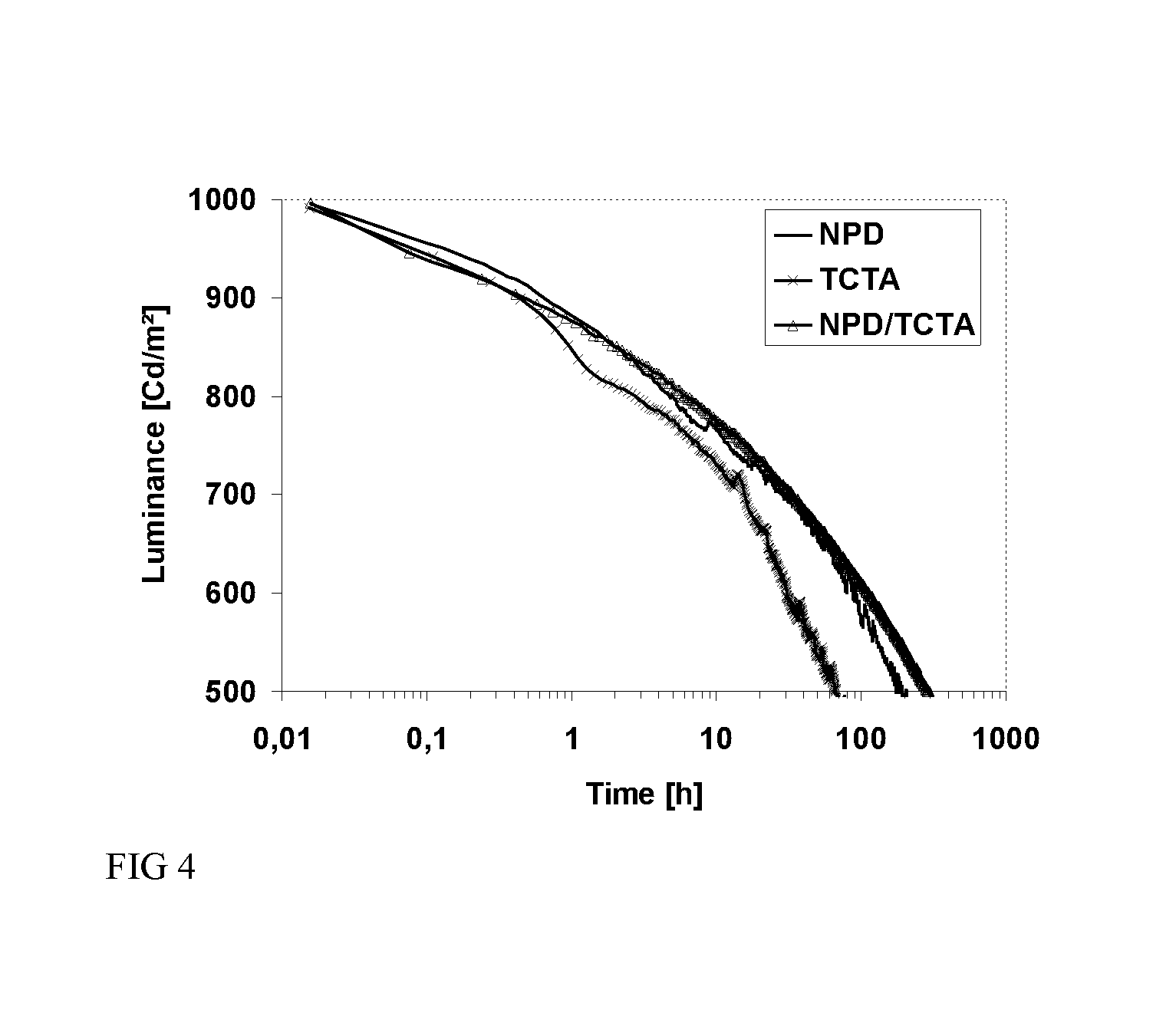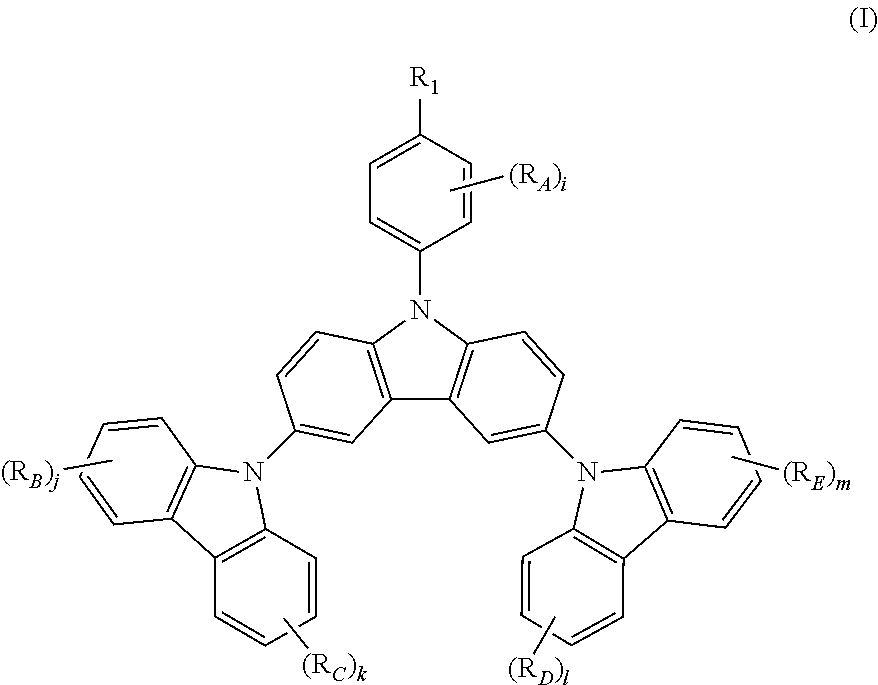N-phenyl triscarbazole
a technology of n-phenyl triscarbazole and compound, which is applied in the direction of non-metal conductors, conductors, thermoelectric devices, etc., can solve the problems of rare high-efficiency blue-light emitting phosphorescent devices, unsatisfactory oled requirements, and unsatisfactory oled materials. achieve the effect of increasing efficiency and li
- Summary
- Abstract
- Description
- Claims
- Application Information
AI Technical Summary
Benefits of technology
Problems solved by technology
Method used
Image
Examples
synthetic example 1
Synthesis of Methyl-Substituted N-Phenyl Triscarbazole Compound
N-(4-tolyl)carbazole—CzMe
[0066]
[0067]A mixture of 30.0 g (0.179 mol, 1.0 eq) of carbazole, 50.9 g (0.233 mol, 1.3 eq) of 4-iodo toluene, 173.5 g (1.25 mol, 7.0 eq) of K2CO3, 159.6 g (2.51 mol, 14 eq) of Cu powder and 2.37 g (0.00897 mol, 5 mol %) of 18-crown-6 are stirred in 900 mL of 1,2-dichlorobenzene at 178° C. under N2 atmosphere for 18 h. The reaction is cooled down at room temperature and the mixture is filtered through a path of Celite and silica which is rinsed by toluene. The filtrate is evaporated under vacuum to give a yellow-brown solid further recrystallized from ethanol to give 29.8 g (0.116 mol, 65%) of CzMe as pale yellow needles.
N-(4-tolyl)-3,6-diiodocarbazole—ICzMe
[0068]
[0069]29.00 g (0.113, 1.0 eq) of CzMe are dissolved in 200 mL of refluxing acetic acid. This solution is then cooled down at 100° C. before the subsequent addition of 24.7 g (0.149 mol, 1.12 eq) of KI and 18.8 g (0.0879 mol, 0.78 eq) of...
synthetic example 2
Synthesis of Fluorine Substituted N-Phenyl Triscarbazole Compound
N-(4-fluorophenyl)carbazole—CzF
[0072]
[0073]A mixture of 20 g (0.120 mol, 1.0 eq) of carbazole, 40 g (0.179 mol, 1.5 eq) of 4-iodo-1-fluorobenzene, 116 g (0.837 mol, 7.0 eq) of K2CO3, 106 g (1.67 mol, 14 eq) of Cu powder and 1.58 g (0.006 mol, 5 mol %) of 18-crown-6 are stirred in 500 mL of dry 1,2-dichlorobenzene at 178° C. under N2 atmosphere for 24 h. The reaction is cooled down at room temperature and the mixture is filtered through a path of Celite and silica which is rinsed by toluene. The filtrate is evaporated under vacuum to give a light-brown solid further crystallized from ethanol to give 24.1 g (0.0922 mol, 77%) of CzF.
N-(4-fluorophenyl)-3,6-diiodocarbazole—ICzF
[0074]
[0075]30 g (0.115 mol, 1.0 eq) of CzF are dissolved in 250 mL of refluxing acetic acid. This solution is then cooled down at 100° C. before the subsequent addition of 25.2 g (0.152 mol, 1.32 eq) of KI and 19.2 g (0.0897 mol, 0.78 eq) of KIO3. Af...
synthetic example 3
Synthesis of Methoxy Substituted N-Phenyl Triscarbazole Compound
N-(4-methoxyphenyl)carbazole—CzOMe
[0078]
[0079]A mixture of 30 g (0.179 mol, 1.0 eq) of carbazole, 54.6 g (0.233 mol, 1.3 eq) of 4-iodoanisole, 173.5 g (1.25 mol, 7.0 eq) of K2CO3, 160 g (2.51 mol, 14 eq) of Cu powder and 2.37 g (0.00897 mol, 5 mol %) of 18-crown-6 are stirred in 1 L of 1,2-dichlorobenzene at 178° C. under N2 atmosphere for 18 h. The reaction is cooled down at room temperature and the mixture is filtered through a path of Celite and silica which is rinsed by toluene. The filtrate is evaporated under vacuum to give a light-brown solid further crystallized from ethanol to give 28.0 g (0.102 mol, 57%) of CzOMe as white needles.
N-(4-methoxyphenyl)-3,6-diiodocarbazole—ICzOMe
[0080]
[0081]27.5 g (0.101 mol, 1.0 eq) of CzOMe are dissolved in 500 mL of refluxing acetic acid. This solution is then cooled down at 100° C. before the subsequent addition of 22.0 g (0.133 mol, 1.32 eq) of KI and 16.8 g (0.078 mol, 0.78 ...
PUM
 Login to View More
Login to View More Abstract
Description
Claims
Application Information
 Login to View More
Login to View More - R&D
- Intellectual Property
- Life Sciences
- Materials
- Tech Scout
- Unparalleled Data Quality
- Higher Quality Content
- 60% Fewer Hallucinations
Browse by: Latest US Patents, China's latest patents, Technical Efficacy Thesaurus, Application Domain, Technology Topic, Popular Technical Reports.
© 2025 PatSnap. All rights reserved.Legal|Privacy policy|Modern Slavery Act Transparency Statement|Sitemap|About US| Contact US: help@patsnap.com



